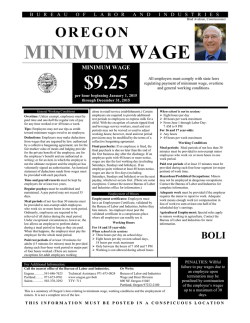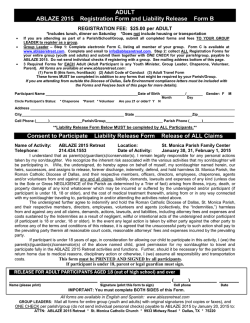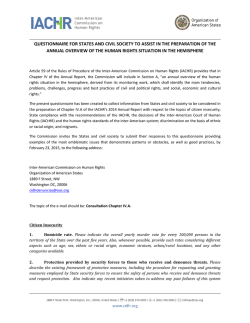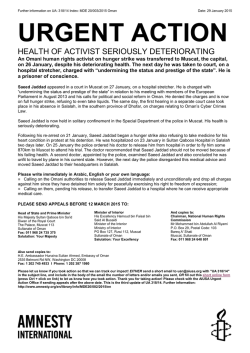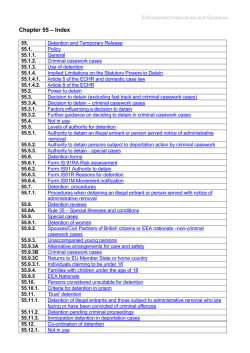
Guidelines for Detention Center Personnel Working with
Guidelines for Detention Center Personnel Working with Unaccompanied Asylum-Seeking Minors Ivelisse Torres Fernández, PhD1 New Mexico State University Co-Chair, NLPA’s Undocumented Student and Immigrant Family Allies (USIFA) Nayeli Chavez-Dueñas, PhD The Chicago School of Professional Psychology NLPA’s Undocumented Student and Immigrant Family Allies (USIFA) Andrés J. Consoli, PhD University of California, Santa Barbara NLPA Leadership Council The United States (U.S.) has a long history of immigration from Central America; however, little attention has been given to the number of minors, including children and adolescents, who travel to the U.S. escaping violence and poverty occurring in their countries of origin (APA, 2012; Suárez-Orozco & Suárez-Orozco, 2001). Fortunately, in recent months, the story of minors attempting to cross the U.S. Mexico border has received significant coverage in the media (Chavez-Dueñas, Adames, & Goertz, 2014). We refer to these minors who are coming to the U.S. with no adult family member or guardian as “unaccompanied asylum-seeking minors.” They are different from immigrant minors as unaccompanied asylum-seeking minors are seeking asylum status in the U.S. Thus, the legal process they undergo is different from that of immigrant minors who may or may not be applying for a permanent residence status in the U.S. While the arrival of unaccompanied asylum-seeking minors is not a new phenomenon; a significant increase in their overall numbers has been observed in recent years. For instance, from 2004 until 2011, immigration officials at the U.S.-Mexico border apprehended approximately 6,800 unaccompanied asylum-seeking minors (NIJC, 2014a). Moreover, during 2012 and then 2013, the number of unaccompanied asylum-seeking minors detained doubled to 13,000 and 24,000 minors respectively. Finally, in 2014, it is estimated that approximately 90,000 unaccompanied asylum-seeking minors will attempt to enter the U.S. without documents (NIJC, 2014b). 1Address correspondence and reprint requests to: Ivelisse Torres Fernandez, Ph.D., New Mexico State University, Email: [email protected]. 2 Nayeli Y. Chavez-Dueñas, Ph.D., The Chicago School of Professional Psychology, Email: [email protected]. 3 Andrés J. Consoli, Ph.D., University of California, Santa Barbara, Email: [email protected]. The authors wish to acknowledge the feedback provided by Joseph M. Cervantes.; Hector Adames, Psy.D.; J. Manuel Casas, Ph.D.; Patricia Arredondo, Ed.D.; Roy Aranda, Psy.D.; Melanie Domenech Rodríguez, Ph.D.; Maritza Gallardo-Cooper, Ph.D.; Claudia Antuña, Psy.D.; Giselle Hass, Psy.D. and Megan Strawsine Carney, Ph.D., to an earlier draft of this document. NLPA January, 2015 Torres-Fernandez, Chavez-Dueñas, & Consoli Page 2 of 7 The National Latina/o Psychological Association (NLPA) is concerned about the challenges unaccompanied asylum-seeking minors from Central America are facing upon their arrival to the U.S. In the spirit of solidarity and advocacy, we offer this set of guidelines for detention center personnel who provide assistance to these minors. To facilitate its use, we have organized the guidelines by areas that contribute to the overall mental health and wellbeing of minors. Physical Needs 1. Extreme poverty that often leads to malnutrition and health concerns has been identified as one of the main reasons that propel migration among children and adolescents (Kennedy, 2014; NIJC, 2014). These problems can be exacerbated by the journey since unaccompanied asylum-seeking minors often do not have access to food and other basic necessities while traveling, resulting in starvation and dehydration. In order to prevent medical complications, it is imperative that once in U.S. custody, these minors receive proper nutrition 2. The journey from Central America to the U.S. is over a thousand miles long and it can take anywhere from a few days to over a month for these minors to arrive at their destination. Many children and adolescents make the journey on top of cargo trains. It is not uncommon for unaccompanied asylum-seeking minors to suffer injuries due to accidents, violence (e.g., assault, kidnapping, rape), walking for long periods of time, and exposure to extreme temperatures (Catholic Relief Services, 2009). As a result, once in U.S. custody, it is recommended that each child receive a thorough physical exam to determine the need for immediate medical attention. 3. Most unaccompanied asylum-seeking minors leave their home countries with very little money, belongings, and often times they are robbed during their journey. As a result, by the time they are detained, many have worn the same clothes for long periods of time. As basic human right for all minors, we invite detention centers to consider the provision of clean, civilian clothes (not uniforms) appropriate for age and climate. This will assist minors to regain some sense of dignity in a context that can be scary and stressful. 4. It is imperative that unaccompanied asylum-seeking minors be treated with dignity and respect, and not like criminals. Detention centers should not be considered a substitute for correction facilities. 5. Detention facilities should also provide appropriate temperatures and lighting to minimize additional stress. Extreme temperatures (i.e., too cold or too hot) and extreme lighting (i.e., bright lights, or no lights) are not only uncomfortable but may also be scary for the minors, prevent them from sleeping, and may trigger traumatic memories. 6. Any detention that extends beyond two weeks should involve periodic screenings for negative psychological consequences brought about by the long detention. Moreover, justification should be made for why a minor continues to be detained. NLPA January, 2015 Torres-Fernandez, Chavez-Dueñas, & Consoli Page 3 of 7 Developmental Needs 1. A careful consideration of developmental needs should be made prior to placing children in detention. It is important to note the needs of minors are specifically related to their stage of development (e.g., children under the age of 12 need constant monitoring, a regular feeding schedule, time to play). Moreover, the potential consequences of keeping children in detention are also associated with their stage of development (e.g., separation from parents and family can lead to attachment difficulties). 2. We recommend that children under the age of 12 under no circumstance be separated from parents/relatives or other significant adults (i.e. adults that are not related by blood but have other culturally acceptable relationships akin to sibling or caregiver) and placed in detention on their own. If they are detained unaccompanied, every effort should be made to reunify children with family as soon as possible. 3. For older children/teenagers who are detained unaccompanied, regular contact with family members/relatives should be allowed. Moreover, we recommend that if at all possible, siblings to be placed in the same facility. 4. We also recommend that detention centers and long-term shelter facilities provide age/developmentally appropriate spaces such as playgrounds and recreational equipment, toys, and furniture. The provision of such spaces creates a welcoming environment for minors and may assist in building safety and trust. Mental Health Needs 1. Safety is an important mental health need for all minors, but particularly for those who have experienced severe trauma. It has been documented that a significant number of unaccompanied asylum-seeking minors leave their home countries fleeing insecurity, violence, and pervasive conditions that threaten their safety, creating a high degree of vulnerability that must be acknowledged (Kennedy, 2014; NIJC, 2014). Therefore, it is imperative that unaccompanied asylum-seeking minors are treated with respect, empathy, and compassion. 2. Another important safety consideration relates to gang members coming with the minors and engaging in bullying behaviors within detention centers/shelters. Therefore, it is imperative that children with histories of violent or out of control behaviors should be separated from the other children in order to avoid the perpetuation of the cycle of violence. 3. Considering that many unaccompanied asylum-seeking minors have not experienced stability in their young lives, it is critical that they are given some sense of stability once in U.S. custody. Stability could have different meanings however, in this context, we recommend that unaccompanied asylum-seeking minors are offered the following: (a) daily routines so they know what to expect from the adults who are caring for them; (b) consistent and accurate information in a developmentally appropriate manner regarding NLPA January, 2015 Torres-Fernandez, Chavez-Dueñas, & Consoli Page 4 of 7 their legal situation and the steps that will be taken to assist them; (c) a safe environment in which their stories are heard, their strengths and resilience are honored, emotional support is provided, and where coping strategies are emphasized. 4. One of the most significant mental health challenges unaccompanied asylum-seeking minors face once they arrive in the U.S. is fear. Thus, they need reassurance that the adults who are caring for them understand their circumstances and will do their best to provide a safe and protective environment. Moreover, they need to know that they matter and that their situation is being seriously considered. 5. One of the most basic human rights of minors is the right to grow up in a safe environment that is free from any type of abuse. This right should be safeguarded while the minors are in U.S. custody. Hence, detention facilities should ensure that minors are protected from all types of abuse including verbal, physical, emotional, and sexual abuse. This is of particular importance given the complaints made by unaccompanied asylumseeking minors regarding alleged verbal, sexual, and physical abuse while in detention (Usova, 2014). Most unaccompanied asylum-seeking minors do not speak and/or understand English when they arrive in the U.S. Furthermore, they might be unaware of cultural norms and expectations. Thus, they should be given access to bilingual workers with whom they can communicate in their native language. Minors who are around individuals with whom they can communicate may feel safer and be more cooperative. If no bilingual personnel are available, professional interpreters who are fluent in the minors’ native language should be made available (APA, 2012). Thus, considering the cultural and linguistic differences, multicultural-Latino sensitive training to staff is highly recommended. 6. In the midst of this humanitarian crisis, it is important for everyone to remember that children and adolescents are not adults. As a vulnerable population, unaccompanied asylum-seeking minors deserve not only to be protected but also to be treated with dignity and to be informed about their legal situation. It is also important to keep in mind that some unaccompanied asylum-seeking minors may lack the cognitive ability to understand the complexity of their legal situation, may have limited knowledge about how to navigate the system, and may lack awareness regarding the implications of seeking asylum in a different country. In order to facilitate minors’ understanding, all information provided to unaccompanied minors should be presented in developmentally sensitive manner. To this end, detention personnel need to be mindful of developmental differences on how children and adolescents process information. Educational and Recreational Needs 1. While in U.S. custody, unaccompanied asylum-seeking minors should have access to books, educational materials, and teachers who speak their native languages and are sensitive to their cultures of origin. Taking into account the educational needs of unaccompanied asylum-seeking minors is not only a human right, but it will also NLPA January, 2015 Torres-Fernandez, Chavez-Dueñas, & Consoli Page 5 of 7 facilitate their adaptation and success in the U.S. (APA, 2012; Suárez-Orozco & SuárezOrozco, 2001). 2. Unaccompanied asylum-seeking minors should be given access to recreational opportunities while in detention centers or long-term shelters. Access to organized sports, exercise, and other playful activities can facilitate coping with the stressful circumstances experienced by these minors. Social Needs 1. Significant social needs are likely to be experienced by unaccompanied asylum-seeking minors once they arrive in the U.S. For instance, overtime minors will begin to miss their country, family, and traditions making their adaptation more difficult. Authorities and personnel working at detention centers are encouraged to facilitate communication and contact between unaccompanied asylum-seeking minors and their families of origin; this can help minors reduce their feelings of nostalgia and isolation. 2. Overcrowding conditions at many detention centers can further complicate the adaptation of unaccompanied asylum-seeking minors. Thus, personnel working at detention centers and shelters are encouraged to proactively manage crowding conditions by instrumenting sequential shifts with respect to eating, hygiene, and recreational activities. 3. It is also important for detention center personnel to be mindful that they function as role models for these minors. As such, they should be thoughtful of the manner in which they express themselves in front of minors so as to minimize the potential for further stigmatization. 4. Detention center personnel are also encouraged to engage in activities that promote respect and appreciation of cultural traditions. Isolation, nostalgia, and other feelings associated with adaptation to the U.S. can be ameliorated by preparing meals that are familiar to these minors, celebrating or acknowledging holidays, birthdays, and other special days, and organizing activities (such as games) that promote sensitivity to cultural differences. Spiritual Needs 1. Spirituality and religion play an integral role in the lives of many minors in Central America. For many of these minors, their faith in Dios and La Virgen is an important source of support and strength in times of fear and uncertainty (Torres Fernandez et al., 2012). Hence, we encourage detention center personnel to provide minors access to clergy for emotional support and attention to their spiritual needs. 2. To the extent possible detention centers and shelters should provide opportunities and spaces where minors can engage in religious/spiritual practices such as praying, reading scripture, or participating in alternative cultural healing practices. NLPA January, 2015 Torres-Fernandez, Chavez-Dueñas, & Consoli Page 6 of 7 Concluding Remarks The humanitarian crisis of the unaccompanied asylum-seeking minors in the U.S. is a painful one. This plight and pain deserves the attention and empathy of all parties involved in their care. NLPA, in it’s commitment to its mission of enhancing the overall well being of Latina/o populations through advocacy and social justice, makes this document available to detention facilities, the professional community, and the community-at-large as a way to raise awareness and offer specific guidelines for the treatment of unaccompanied asylum-seeking minors. It does so with the specific purpose of pursuing the amelioration of the suffering experienced by our unaccompanied asylum-seeking minors. We invite the reader to help us improve the document by contacting the authors and providing input. NLPA January, 2015 Torres-Fernandez, Chavez-Dueñas, & Consoli Page 7 of 7 References American Psychological Association, Presidential Task Force on Immigration. (2012). Crossroads: The psychology of immigration in the new century. Washington, DC: Author. Catholic Relief Services. (2009). Child migration: The detention and repatriation of unaccompanied Central American children from Mexico. Retrieved from http://www.crsprogramquality.org/storage/pubs/peacebuilding/LACRO%20Migrationfinal.pdf Chavez-Dueñas, N., Adames, H. Y., & Goertz, M. T. (2014). Esperanza sin fronteras: Understanding the complexities surrounding the unaccompanied refugee children from Central America. Latina/o Psychology Today, 1(1), 10-14. Kennedy, E. (2014). No children here: Why Central American children are fleeing their homes. American Immigration Council (AIC). Retrieved from http://www.immigrationpolicy.org/sites/adefault/files/docs/no_childhood_here_w y_centr al_american_children_are_fleeing_their_homes_f National Immigrant Justice Center. (2014a). Unaccompanied immigrant children: A policy brief from Heartland Alliance’s National Immigrant Justice Center. Retrieved from https://immigrantjustice.org/sites/ immigrantjustice.org/files/NIJC%20Policy %20Brief%20 %20Unaccompanied%20 Immigrant%20Children%20FINAL%20 Winter%202014.pdf National Immigrant Justice Center. (2014b). The refugee crisis at the U.S. border: Separating fact from fiction. Retrieved from http://www.immigrantjustice.org/sites/ immigrantjustice.org/files/Crisis%20on% 20the%20Border%20UACs%20Onepager_2014_06_26.pdf Suárez-Orozco, C. & Suárez-Orozco, M. (2001). Children of immigration. Cambridge, MA: Harvard University Press. Torres Fernandez, I., Rios, G. O., James, A. L., Martinez, A., & Bravo, A. (2012). Cruzando fronteras: Addressing trauma and grief in children impacted by the violence in the USMexico border. Revista Interamericana de Psicologia/Interamerican Journal of Psychology, 46, 425-434. Usova, G. M. (2014). Doing right by the unaccompanied children on our border. Retrieved from: www.aclu.org/blog/immigrants-rights/doing-right-unaccompanied-children-border.
© Copyright 2025
